Carnegie library
A Carnegie library is a library built with money donated by Scottish-American businessman and philanthropist Andrew Carnegie. A total of 2,509 Carnegie libraries were built between 1883 and 1929, including some belonging to public and university library systems. 1,689 were built in the United States, 660 in the United Kingdom and Ireland, 125 in Canada, and others in Australia, South Africa, New Zealand, Serbia, Belgium, France, the Caribbean, Mauritius, Malaysia and Fiji.
At first, Carnegie libraries were almost exclusively in places where he had a personal connection, namely his home-town in Scotland and the Pittsburgh, Pennsylvania area. Beginning in 1899, Carnegie substantially increased funding to libraries outside of these areas.
In later years few towns that requested a grant and agreed to his terms were refused. By the time the last grant was made in 1919, there were 3,500 libraries in the United States, nearly half of them built with construction grants paid by Carnegie.

History
The first of Carnegie's public libraries, Dunfermline Carnegie Library was in his birthplace, Dunfermline, Scotland. It was first commissioned or granted by Carnegie in 1880 to James Campbell Walker[2] and would open in 1883. The locally quarried sandstone building displays a stylized sun with the carved motto "Let there be light" at the front entrance.
The first library in the United States to be commissioned by Carnegie was in 1886 in his adopted hometown of Allegheny, Pennsylvania (now the North Side of Pittsburgh). In 1890, it became the second of his libraries to open in the USA. The building also contained the first Carnegie Music Hall in the World.
The first Carnegie library to open in the United States was in 1889 in Braddock, Pennsylvania, about 9 miles up the river from Pittsburgh, and home to one of the Carnegie Steel Company's mills. It was the second Carnegie Library in the United States to be commissioned, 1887, and was the first of just four libraries that he fully endowed. An 1893 addition doubled the size of the building and included the third Carnegie Music Hall in the United States.
Initially Carnegie limited his support to a few towns in which he had an interest. These would be in Scotland and the Pittsburgh, Pennsylvania area. In America, 6 out of the first 7, 7 of the first 10, and 9 of the first 13 libraries he commissioned are all found in Southwestern Pennsylvania. Architectural critic Patricia Lowry wrote "to this day, Carnegie's free-to-the-people libraries remain Pittsburgh's most significant cultural export, a gift that has shaped the minds and lives of millions."[3]
Until 1898, only one library was commissioned in America outside of Southwestern Pennsylvania—a library in Fairfield, Iowa, commissioned in 1892. Since this marked the first time that Carnegie had funded a library in which he had no personal ties, it helped initiate the funding model that would be used by Carnegie for thousands of additional libraries.[4]
Beginning in 1899, his foundation funded a dramatic increase in the number of libraries. This coincided with the rise of women's clubs in the post-Civil War period, which were most responsible for organizing efforts to establish libraries, including long-term fundraising and lobbying within their communities to support operations and collections.[5] They led the establishment of 75–80 percent of the libraries in communities across the country.[6]
Carnegie believed in giving to the "industrious and ambitious; not those who need everything done for them, but those who, being most anxious and able to help themselves, deserve and will be benefited by help from others."[7] Under segregation black people were generally denied access to public libraries in the Southern United States. Rather than insisting on his libraries being racially integrated, Carnegie funded separate libraries for African Americans. For example, in Houston he funded a separate Colored Carnegie Library.[8] The Carnegie Library in Savannah, Georgia, opened in 1914 to serve black residents, who had been excluded from the public library. The privately organized Colored Library Association of Savannah had raised money and collected books to establish a small Library for Colored Citizens. Having demonstrated their willingness to support a library, the group then petitioned for and received funds from Carnegie.[9] Future U.S. Supreme Court Justice Clarence Thomas wrote in his memoirs that he frequently used it as a boy, before the library system was desegregated.[10]
Most of the library buildings were unique, constructed in a number of styles, including Beaux-Arts, Italian Renaissance, Baroque, Classical Revival, and Spanish Colonial. Scottish Baronial was one of the styles used in Carnegie's native Scotland. Each style was chosen by the community, although as the years went by James Bertram, Carnegie's secretary, became less tolerant of designs which were not to his taste.[11] Edward Lippincott Tilton, a friend often recommended by Bertram, designed many of the buildings.[12] The architecture was typically simple and formal, welcoming patrons to enter through a prominent doorway, nearly always accessed via a staircase. The entry staircase symbolized a person's elevation by learning. Similarly, outside virtually every library was a lamppost or lantern, meant as a symbol of enlightenment.
In the early 20th century, a Carnegie library was often the most imposing structure in hundreds of small American communities.
-

Carnegie Free Library of Braddock in Braddock, Pennsylvania, built in 1888, was the first Carnegie Library in the United States to open (1889) and the first of four to be fully endowed.
-
Edinburgh Central Library, opened on June 9, 1890.
-

Detail of the entrance to the Carnegie Library in Avondale, Cincinnati (1902) (Spanish colonial style).
-

Carnegie library in Columbia-Tusculum, Cincinnati (1906) in the Beaux-Arts style.
-
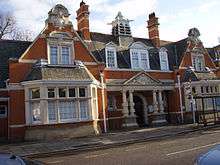
Carnegie Library in Teddington, England, was built in 1906 in Edwardian Baroque style.
-
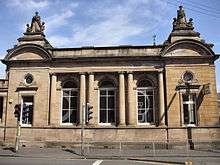
Govan & Crosshill District Library, Scotland, built in 1906 by architect James Robert Rhind.
-

Carnegie Library, San Antonio, Texas (1900-1924).
-
Carnegie Library opened in 1916 in Grass Valley, California, (neoclassical style).
-

Carnegie Library in Belgrade, Serbia - Belgrade University Library, built in 1921.
-
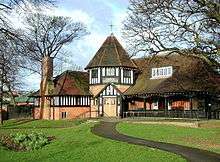
Carnegie Library in Hull, England, now houses the Carnegie Heritage Centre, (Half-timbered architecture).
-

Carnegie Library in Iron Mountain, Michigan. It now houses a history museum.
-

Carnegie Library, Waupun, Wisconsin.
-

The Carnegie Library in Union, Oregon.
-

Carnegie Library building in Davenport, Iowa.(1889-1966)
-

The Carnegie Library in Portadown, Northern Ireland.
-
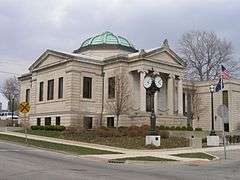
Carnegie Library of Wabash, Wabash County Indiana
-
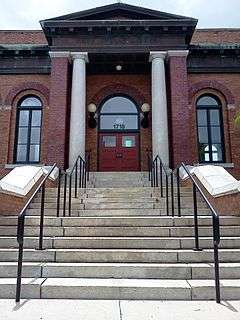
Carnegie Library West Tampa Free Public Library in Tampa, Florida opened in 1914.
-
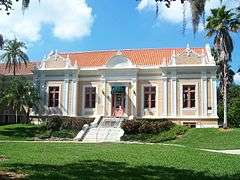
St. Petersburg Public Library or Mirror Lake Library or Carnegie Library built in 1915 in St. Petersburg, Florida.
-

Beaumont Library District in Beaumont, California, opened in 1914.
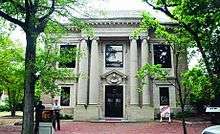
Background
Books and libraries were important to Carnegie, beginning with his early childhood in Scotland and his teen years in Allegheny/Pittsburgh. There he listened to readings and discussions of books from the Tradesman's Subscription Library, which his father helped create. Later in Pennsylvania, while working for the local telegraph company in Pittsburgh, Carnegie borrowed books from the personal library of Colonel James Anderson, who opened his collection to his workers every Saturday. Anderson, like Carnegie, resided in Allegheny.
In his autobiography, Carnegie credited Anderson with providing an opportunity for "working boys" (that some said should not be "entitled to books") to acquire the knowledge to improve themselves.[13] Carnegie's personal experience as an immigrant, who with help from others worked his way into a position of wealth, reinforced his belief in a society based on merit, where anyone who worked hard could become successful. This conviction was a major element of his philosophy of giving in general, and of his libraries as its best known expression.
Carnegie formula
Nearly all of Carnegie's libraries were built according to "the Carnegie formula," which required financial commitments from the town that received the donation. Carnegie required public support rather than making endowments because, as he wrote:
- "an endowed institution is liable to become the prey of a clique. The public ceases to take interest in it, or, rather, never acquires interest in it. The rule has been violated which requires the recipients to help themselves. Everything has been done for the community instead of its being only helped to help itself."[14]
Carnegie required the elected officials—the local government—to:
- demonstrate the need for a public library;
- provide the building site;
- pay to staff and maintain the library;
- draw from public funds to run the library—not use only private donations;
- annually provide ten percent of the cost of the library's construction to support its operation; and,
- provide free service to all.
Carnegie assigned the decisions to his assistant James Bertram. He created a "Schedule of Questions." The schedule included: Name, status and population of town, Does it have a library? Where is it located and is it public or private? How many books? Is a town-owned site available? Estimation of the community's population at this stage was done by local officials, and Bertram later commented if the population counts he received were truly accurate, "the nation's population had mysteriously doubled".[15]
The impact of Carnegie's library philanthropy was maximized by his timing. His offers came at a peak of town development and library expansion in the US. By 1890, many states had begun to take an active role in organizing public libraries, and the new buildings filled a tremendous need. Interest in libraries was also heightened at a crucial time in their early development by Carnegie's high profile and his genuine belief in their importance.[16]
In Canada in 1901 Carnegie offered more than $2.5 million to build 125 libraries. Most cities at first turned him down—then relented and took the money.[17]
Self-service stacks
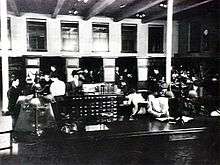
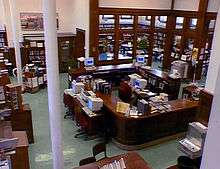

The first five Carnegie libraries followed a closed stacks policy, the method of operation common to libraries at that time. Patrons requested a book from a library staffer, who would fetch the book from closed stacks off limits to the public, and bring it to a delivery desk.
To reduce operating costs, Carnegie created a then revolutionary open-shelf or self-service policy beginning with the Pittsburgh neighborhood branches that opened after the main branch. This streamlined process allowed open access to shelves by patrons. Carnegie's architects designed the Pittsburgh neighborhood branches so that one librarian could oversee the entire operation.
Theft of books and other items was a major concern in this era before electronic anti-theft devices. Thus the library's circulation desk—which replaced the delivery desk used in traditional closed stacks libraries—was strategically positioned just inside the front door. Bigger and more daunting than those used in modern libraries, these desks spanned almost the width of the lobby and acted as a physical and psychological barrier between the front entrance and the book room. Decades later, Joyce Broadus, the manager of Pittsburgh's Homewood branch, was credited with dubbing this design of the front desk "the battleship."
The first of these 'open stack' branches was in the neighborhood of Lawrenceville—the sixth Carnegie library to open in America. The next was in the West End branch—the eighth Carnegie library to open in America. Patricia Lowry describes
located just beyond the lobby, the circulation desk – no longer a delivery desk – took center stage in Lawrenceville, flanked by turnstiles that admitted readers to the open stacks one at a time, under the librarian's watchful eye. To thwart thievery, the stacks were arranged in a radial pattern. On each side of the lobby were a general reading room and, for the first time in a library anywhere, a room for children.... The reading rooms were separated by walls that became glass partitions above waist level—the better to see you with, my dear.[3]
Walter E. Langsam, an architectural historian and teacher at the University of Cincinnati wrote "The Carnegie libraries were important because they had open stacks which encouraged people to browse .... People could choose for themselves what books they wanted to read."[18] This open stacks policy would eventually be adopted by the libraries that previously had opened with a closed stacks policy.
Continuing legacy
Carnegie established charitable trusts which have continued his philanthropic work. However, even before his death they had reduced their involvement in the provision of libraries. There has continued to be support for library projects, for example in South Africa.[19]
In 1992, The New York Times reported that, according to a survey conducted by George Bobinksi, dean of the School of Information and Library Studies at the State University at Buffalo, 1,554 of the 1,681 original buildings in the United States still existed, with 911 still used as libraries. Two-hundred seventy-six were unchanged, 286 had been expanded, and 175 had been remodeled. Two-hundred forty three had been demolished while others had been converted to other uses.[20]
While hundreds of the library buildings have become museums, community centers, office buildings, residences, or are otherwise used, more than half of those in the United States still serve their communities as libraries over a century after their construction,[21] many in middle- to low-income neighborhoods. For example, Carnegie libraries still form the nucleus of the New York Public Library system in New York City, with 31 of the original 39 buildings still in operation. Also, the main library and eighteen branches of the Pittsburgh public library system are Carnegie libraries. The public library system there is named the Carnegie Library of Pittsburgh.[22]

In the late 1940s, the Carnegie Corporation of New York arranged for microfilming of the correspondence files relating to Andrew Carnegie's gifts and grants to communities for the public libraries and church organs. They then discarded the original materials. The microfilms are open for research as part of the Carnegie Corporation of New York Records collection, residing at Columbia University Rare Book and Manuscript Library.[23] Archivists did not microfilm photographs and blueprints of the Carnegie Libraries. The number and nature of documents within the correspondence files varies widely. Such documents may include correspondence, completed applications and questionnaires, newspaper clippings, illustrations, and building dedication programs.
UK correspondence files relating to individual libraries have been preserved in Edinburgh (see the article List of Carnegie libraries in Europe).
Beginning in the 1930s, some libraries were meticulously measured, documented and photographed under the Historic American Buildings Survey (HABS) program of the National Park Service,[24] and other documentation has been collected by local historical societies. In 1935, the centennial of his Carnegie's birth, a copy of the portrait of him originally painted by F. Luis Mora was given to libraries he helped fund.[25] Many of the Carnegie libraries in the United States, whatever their current uses, have been recognized by listing on the National Register of Historic Places. The first of these, in Braddock, Pennsylvania, was designated a National Historic Landmark in March 2012.
Lists of Carnegie libraries
- List of Carnegie libraries in Africa, the Caribbean and Oceania
- List of Carnegie libraries in Canada
- List of Carnegie libraries in Europe
- List of Carnegie libraries in the United States
See also
Notes
- ↑ National Portrait Gallery catalogue
- ↑ "James Campbell Walker". Dictionary of Scottish Architects. Retrieved September 3, 2016.
- 1 2 "Carnegie's Library Legacy".
- ↑ "Carnegie Historical Museum - Fairfield Cultural District". fairfieldculturaldistrict.org.
- ↑ Paula D. Watson, “Founding Mothers: The Contribution of Women’s Organizations to Public Library Development in the United States”, Library Quarterly, Vol. 64, Issue 3, 1994, p.236
- ↑ Teva Scheer, “The “Praxis” Side of the Equation: Club Women and American Public Administration”, Administrative Theory & Praxis, Vol. 24, Issue 3, 2002, p.525
- ↑ Andrew Carnegie, "The Best Fields for Philanthropy", The North American Review, Volume 149, Issue 397, December 1889 from the Cornell University Library website
- ↑ This library has been discussed in Cheryl Knott Malone's essay, "Houston's Colored Carnegie Library, 1907–1922", which while still in manuscript won the Justin Winsor Prize in 1997. Accessed on-line August 2008 in a revised version
- ↑ Live Oak Public Libraries: Library History, "Archived copy". Archived from the original on August 19, 2014. Retrieved August 18, 2014. (main page) "Archived copy" (PDF). Archived from the original (PDF) on March 20, 2015. Retrieved August 18, 2014. (details), accessed August 17, 2014.
- ↑ Clarence Thomas, My Grandfather's Son: A Memoir, HarperCollins, 2008, pp. 17, 29, 30, Google Books
- ↑ "Carnegie Libraries--Reading 2".
- ↑ Mausolf, Lisa B.; Hengen, Elizabeth Durfee (2007), Edward Lippincott Tilton: A Monograph on His Architectural Practice (PDF), retrieved September 28, 2011,
Many of these were Carnegie Libraries, public libraries built between 1886 and 1917 with funds provided by Andrew Carnegie or the Carnegie Corporation of New York. In all, Carnegie funding was provided for 1,681 public library buildings in 1,412 U.S. communities, with additional libraries abroad. Increasingly after 1908, Carnegie library commissions tended to be in the hands of a relatively small number of firms that specialized in library design. Tilton benefited from a friendship with James Bertram, who was responsible for reviewing plans for Carnegie-financed library buildings. Although the Carnegie program left the hiring of an architect to local officials, Bertram’s personal letters of introduction gave Tilton a distinct advantage. As a result, Tilton won a large number of comparatively modest Carnegie library commissions, primarily in the northeast. Typically, Tilton furnished all plans, working drawings, details and specifications and then associated with a local architect who would supervise construction and receive 5% of Tilton’s commission.
- ↑ "Andrew Carnegie: A Tribute: Colonel James Anderson" Archived February 11, 2004, at the Wayback Machine., Exhibit, Carnegie Library of Pittsburgh
- ↑ Carnegie, Andrew (December 1889). "The Best Fields for Philanthropy". North American Review. 149: 688–691.
- ↑ Gigler, Rich (July 17, 1983). "Thanks, but no thanks". The Pittsburgh Press. p. 12. Retrieved May 26, 2015.
- ↑ Bobinski, p. 191
- ↑ Susan Goldenberg, "Dubious Donations," Beaver (2008) 88#2
- ↑ Al Andry, "New Life for Historic Libraries", The Cincinnati Post, October 11, 1999
- ↑ The Carnegie Corporation and South Africa: Non-European Library Services Archived August 28, 2008, at the Wayback Machine. Libraries & Culture, Volume 34, No. 1 Archived June 12, 2010, at the Wayback Machine. (Winter 1999), from the University of Texas at Austin
- ↑ Strum, Charles (March 2, 1992), "BELLEVILLE JOURNAL; Restoring Heritage and Raising Hopes for Future", The New York Times, retrieved September 29, 2011,
Dr. George Bobinksi, dean of the School of Information and Library Studies at the State University at Buffalo, says 1,681 libraries were built with Carnegie money, mostly between 1898 and 1917.In a survey, he found that at least 1,554 of the buildings still exist, with only 911 of these still in use as public libraries. At least 276 of the survivors are unchanged, while 243 have been demolished, 286 have been expanded and 175 have been remodeled. Others have been turned into condominiums, community centers or shops.
- ↑ "Carnegie libraries by state" (PDF). American Volksporting Association. 1996. Archived from the original (PDF) on April 14, 2012. Retrieved October 3, 2011.
- ↑ http://www.carnegielibrary.org/
- ↑ "Rare Book & Manuscript Library".
- ↑ Historic American Buildings Survey/Historic American Engineering Record (HABS/HAER), Permanent Collection, American Memory from the Library of Congress
- ↑ "Belmar Public Library". Wall, New Jersey. American towns. Retrieved October 3, 2011.
Further reading
- Anderson, Florence. Carnegie Corporation Library Program, 1911-1961... (Carnegie Corporation of New York, 1963)
- Bobinski, George S. "Carnegie libraries: Their history and impact on American public library development." ALA Bulletin (1968): 1361-1367. in JSTOR
- Grimes, Brendan. (1998). Irish Carnegie Libraries: A catalogue and architectural history, Irish Academic Press. ISBN 0-7165-2618-2
- Jones, Theodore. (1997). Carnegie Libraries Across America: A Public Legacy, John Wiley & Sons. ISBN 0-471-14422-3
- Lorenzen,Michael. (1999). "Deconstructing the Carnegie Libraries: The Sociological Reasons Behind Carnegie's Millions to Public Libraries", Illinois Libraries. 81, no. 2: 75–78.
- Martin, Robert Sidney. Carnegie denied: communities rejecting Carnegie Library construction grants, 1898-1925 (Greenwood Press, 1993)
- Miner, Curtis. "The'Deserted Parthenon': Class, Culture and the Carnegie Library of Homestead, 1898–1937." Pennsylvania History (1990): 107-135. in JSTOR
- Nasaw, David. Andrew Carnegie. New York: Penguin Press, 2006.
- Pollak, Oliver B. A State of Readers, Nebraska's Carnegie Libraries, (Lincoln: J. & L. Lee Publishers, 2005).
- Prizeman, Oriel. Philanthropy and light: Carnegie libraries and the advent of transatlantic standards for public space (Ashgate, 2013)
External links
- Skeen, Molly. (March 5, 2004) "How America's Carnegie Libraries Adapt to Survive", Preservation Online.
- December 10, 2002. "Yorkville Library Celebrates Centennial", The New York Public Library.
| Wikimedia Commons has media related to Carnegie libraries. |
- Carnegie Collections from the Columbia University Library System website
- "Carnegie Libraries: The Future Made Bright", National Park Service Teaching with Historic Places lesson plan
- Map timeline of Carnegie Libraries in the United States 1890-1921
- Selected websites for Carnegie Libraries in specific countries or U.S. states
- UK and Ireland
- Scotland
- Puerto Rico (Spanish)
- California
- Florida
- Michigan at the Wayback Machine (archived October 6, 2007)
- New England Carnegies
- Oklahoma
- South Carolina
- Wisconsin


